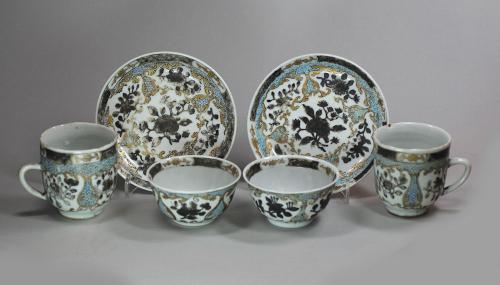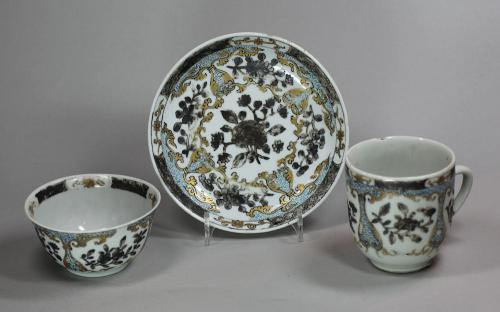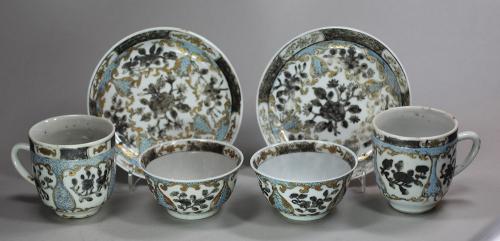
This object is eligible for a Certificate of BADA Provenance
The BADA Standard
- Since 1918, BADA has been the leading association for the antiques and fine art trade
- Members are elected for their knowledge, integrity and quality of stock
- Our clients are protected by BADA’s code of conduct
- Our dealers’ membership is reviewed and renewed annually
- Bada.org is a non-profit site: clients deal directly with members and they pay no hidden fees
A Large Chinese blue and white jar, Ming dynasty (1368-1644), decorated with Shoulao riding a crane across the sea in descent from the heavens, the eight immortals gathered on a mountainous shoreline amongst pine and scrolling clouds, the neck with curling floral design.
Shoulao, the Daoist god of longevity, is instantly recognisable by his large pointed forehead, representing great wisdom. He is frequently depicted with a crane and a scroll; here the crane upon which he rides holds the scroll in its beak. The immortal crane (xian he) is connected with the Immortals as the bird is said to live for thousands of years and act as messenger between the earthly and heavenly realms, where the Daoist deities reside.
The Eight Immortals are a legendary group of Daoist figures said to have lived during the Tang or Song dynasties, and appear as a group on artwork dating back to the Jin dynasty, though evidence survives suggesting that worship of individual Daoist immortal figures was prevalent during the Han.
Here they are depicted from left to right as follows: Lu Dongbin呂洞賓, a scholar and poet considered the leader of the immortals and depicted here presenting Shoulao with peaches; Zhongli Quan 鍾離權, associated with death and said to be able to produce precious metals, depicted holding a fan; Cao Guojiu曹國舅, said to be related to a Song dynasty emperor in his mortal life, depicted in official robes and holding ‘paiban’ (traditional Chinese clappers), regarded as the patron deity of the performing arts; Zhang Guolao張果老, depicted carrying a fish drum (a tube-shaped bamboo drum with two iron striking rods); Han Xiangzi韓湘子, a flautist; He Xiangu何仙姑, a female immortal often depicted holding a lotus; Lan Caihe藍采和, originally depicted in female form as seen here, the patron deity of florists and gardeners; Li Tieguai李鐵拐, associated with medicine and easing the suffering of the sick, identifiable by his calabash bottle.
Although depiction of the Immortals had long been part of Chinese artistic tradition, a peak in the popularity of Daoism during the Ming dynasty led to a renewed interest in the school’s central themes and figures; an interest reflected in Ming art and ceramic design.
Daoism, which is based upon the belief in an underlying universal order and the attainment of immortality through living in balance with the natural world, was of particular personal importance to emperor Jiajing (reigned 1522-66), who devoted himself to the search for an elixir of immortality.
In addition to the overt emblems and figures of immortality depicted, natural imagery contributes to this jar's Daoist symbolism; for example the clouds represent mystical vapours that issue forth from the gateways between the human world and immortal paradise.
The peaches being offered to by Shoulao by Zhongli Quan indicate that the scene depicted is in fact the Feast of the Peaches蟠桃會, held by the Jade Emperor, ruler of all of the Heavens and his wife, the Queen Mother of the West. This legendary banquet features prominently in Ming novels including Journey to the West西遊記 (attributed to Wu Cheng’en circa 1500-1580).
It is supposedly held at the Jade Pool of the Emperor’s Golden-Gate Cloud Palace to celebrate the ripening of the peaches from the Queen Mother’s Garden. These peaches of immortality (pantao蟠桃) only ripen every few thousand years, and are shared amongst the immortals to sustain them until the next banquet.
Dimensions
Height 33 cm. (13in.)Stock number
W637The BADA Standard
- Since 1918, BADA has been the leading association for the antiques and fine art trade
- Members are elected for their knowledge, integrity and quality of stock
- Our clients are protected by BADA’s code of conduct
- Our dealers’ membership is reviewed and renewed annually
- Bada.org is a non-profit site: clients deal directly with members and they pay no hidden fees




